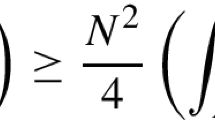Abstract
We study the geometrical properties of the utility space (the space of expected utilities over a finite set of options), which is commonly used to model the preferences of an agent in a situation of uncertainty. We focus on the case where the model is neutral with respect to the available options, i.e. treats them, a priori, as being symmetrical from one another. Specifically, we prove that the only Riemannian metric that respects the geometrical properties and the natural symmetries of the utility space is the round metric. This canonical metric allows to define a uniform probability over the utility space and to naturally generalize the Impartial Culture to a model with expected utilities.
Access this chapter
Tax calculation will be finalised at checkout
Purchases are for personal use only
Similar content being viewed by others
Notes
- 1.
This is not always the case: for example, Gibbard [7] considers voters with expected utilities over the candidates.
- 2.
The necessary and sufficient condition is that relation \(\le \) is complete, transitive, archimedean and independent of irrelevant alternatives.
- 3.
Technically, this remark proves that \(\mathcal {U}_m\) (with its natural quotient topology) is not a \(T_1\) space [8].
References
Audin, M.: Geometry. Universitext. Springer, Heidelberg (2003)
Arrow, K.J.: A difficulty in the concept of social welfare. J. Polit. Econ. 58(4), 328–346 (1950)
Beltrami, E.: Résolution du problème de reporter les points d’une surface sur un plan, de manière que les lignes géodésiques soient représentée par des lignes droites. Annali di Matematica (1866)
Beltrami, E.: Essai d’interprétation de la géométrie noneuclidéenne. Trad. par J. Hoüel. Ann. Sci. École Norm. Sup. 6, 251–288 (1869)
Fishburn, P.C.: Utility Theory for Decision Making. Wiley, New York (1970)
Fishburn, P.C.: Nonlinear Preference and Utility Theory. Johns Hopkins Series in the Mathematical Sciences. Johns Hopkins University Press, Baltimore (1988)
Gibbard, A.: Straightforwardness of game forms with lotteries as outcomes. Econometrica 46(3), 595–614 (1978)
Guénard, F., Lelièvre, G.: Compléments d’analyse. Compléments d’analyse, E.N.S. 1 (1985)
Hammond, P.J.: Interpersonal comparisons of utility: why and how they are and should be made. In: Elster, J., Roemer, J.E. (eds.) Interpersonal Comparisons of Well-Being, pp. 200–254. Cambridge University Press, Cambridge (1991)
Kreps, D.M.: A Course in Microeconomic Theory. Princeton University Press, Princeton (1990)
Mallows, C.L.: Non-null ranking models. Biometrika 44(1/2), 114–130 (1957)
Mas-Colell, A., Whinston, M.D., Green, J.R.: Microeconomic Theory. Oxford University Press, Oxford (1995)
Spivak, M.: A Comprehensive Introduction to Differential Geometry, vol. III. Second edn. Publish or Perish Inc., Wilmington (1979)
Spivak, M.: A Comprehensive Introduction to Differential Geometry, vol. IV. Second edn. Publish or Perish Inc., Wilmington (1979)
Ulrich, G.: Computer generation of distributions on the m-sphere. Appl. Stat. 33(2), 158–163 (1984)
Von Neumann, J., Morgenstern, O., Kuhn, H.W., Rubinstein, A.: Theory of Games and Economic Behavior. Commemorative edn. Princeton University Press, Princeton, Princeton Classic Editions (2007)
Von Neumann, J., Morgenstern, O.: Theory of Games and Economic Behavior. Princeton University Press, Princeton (1944)
Wood, A.T.A.: Simulation of the von mises fisher distribution. Commun. Stat. Simul. Comput. 23(1), 157–164 (1994)
Acknowledgments
The work presented in this paper has been partially carried out at LINCS (http://www.lincs.fr).
Author information
Authors and Affiliations
Corresponding author
Editor information
Editors and Affiliations
Rights and permissions
Copyright information
© 2015 Springer International Publishing Switzerland
About this paper
Cite this paper
Durand, F., Kloeckner, B., Mathieu, F., Noirie, L. (2015). Geometry on the Utility Space. In: Walsh, T. (eds) Algorithmic Decision Theory. ADT 2015. Lecture Notes in Computer Science(), vol 9346. Springer, Cham. https://doi.org/10.1007/978-3-319-23114-3_12
Download citation
DOI: https://doi.org/10.1007/978-3-319-23114-3_12
Published:
Publisher Name: Springer, Cham
Print ISBN: 978-3-319-23113-6
Online ISBN: 978-3-319-23114-3
eBook Packages: Computer ScienceComputer Science (R0)




